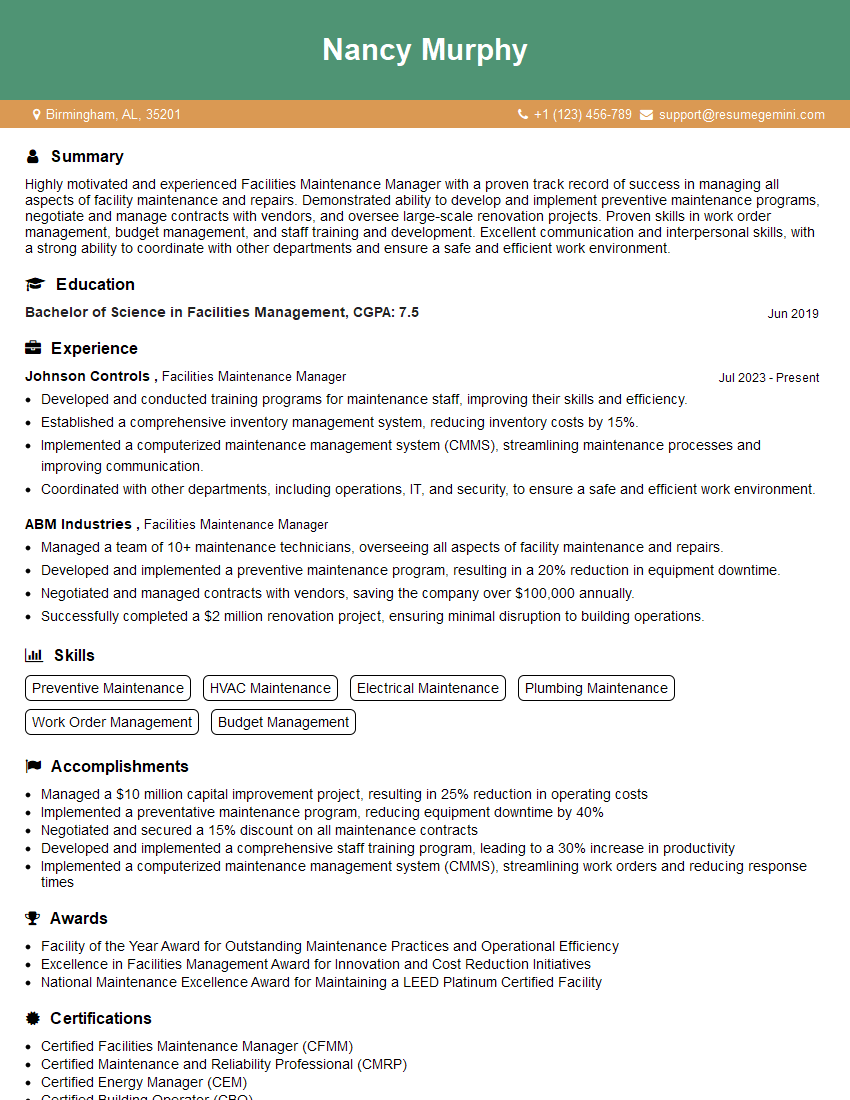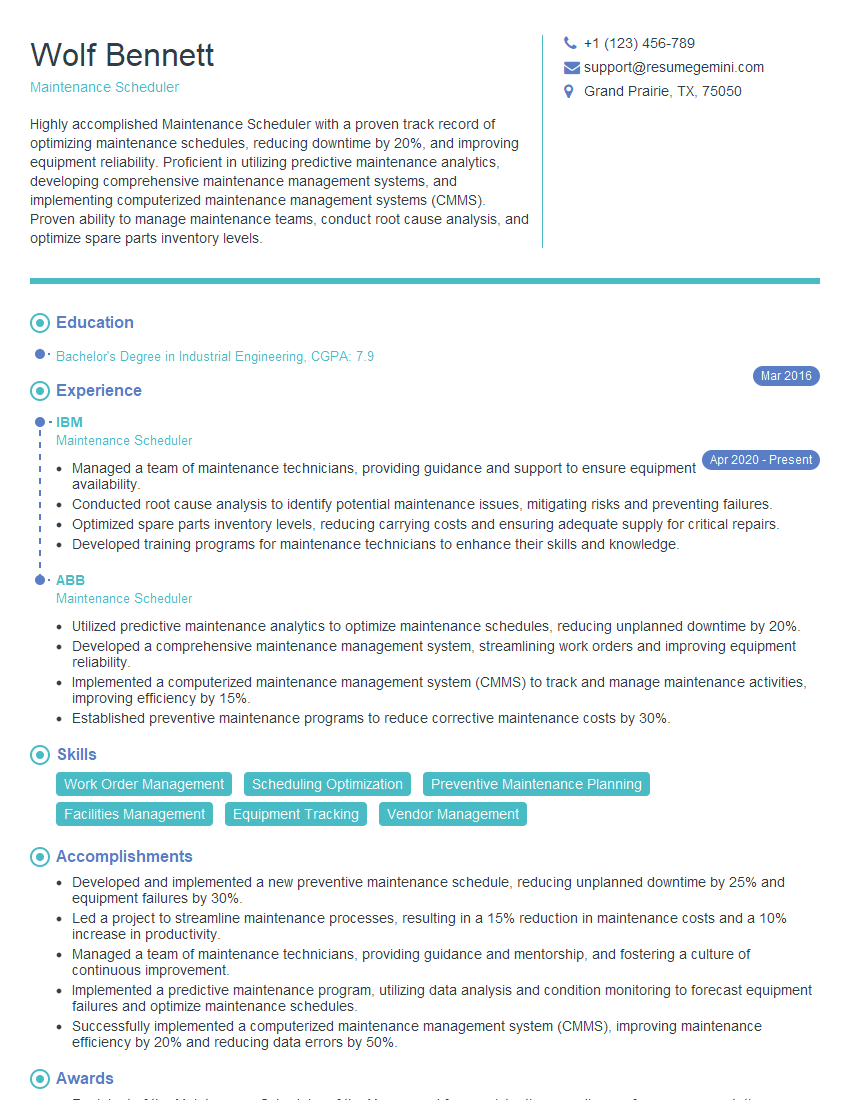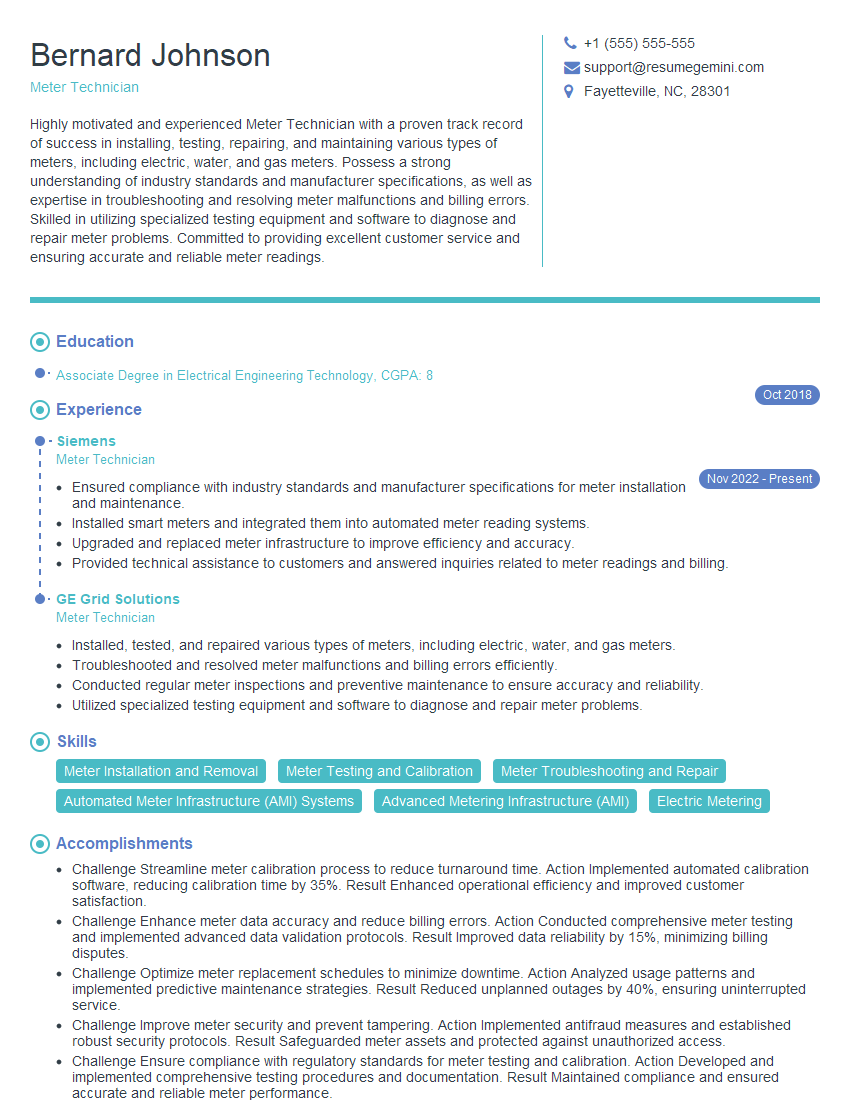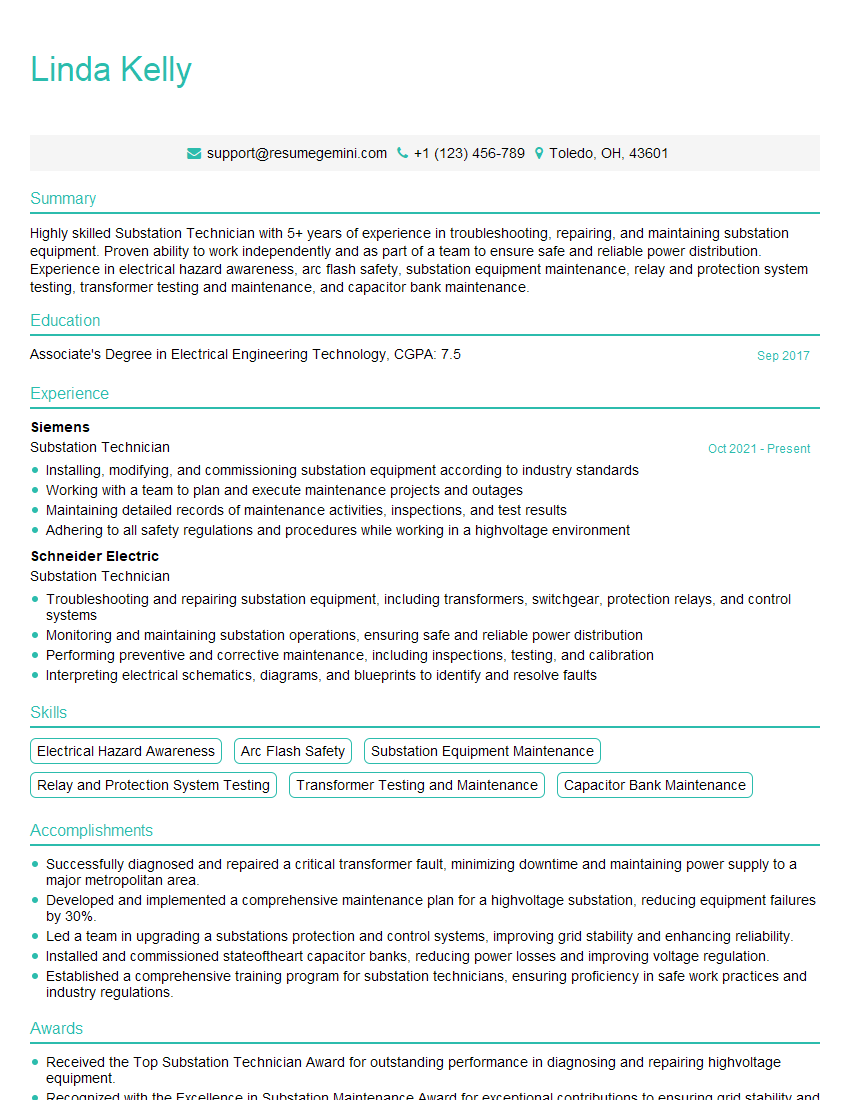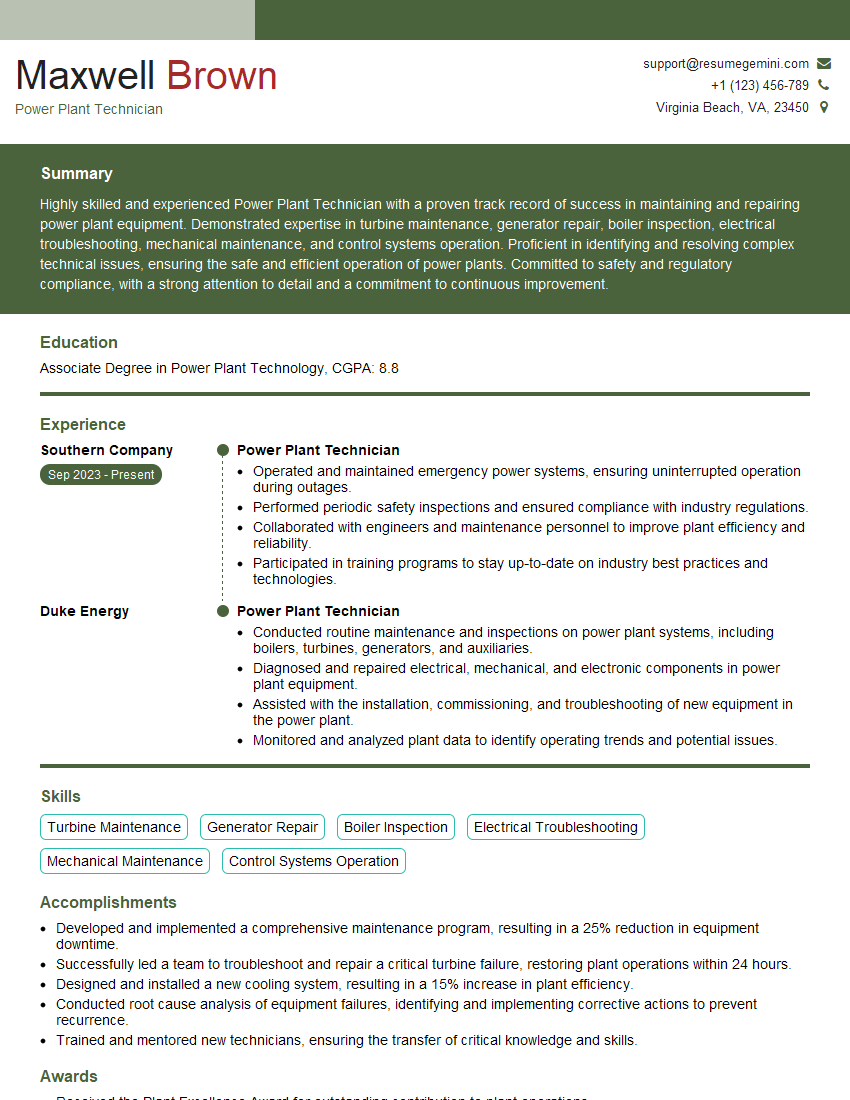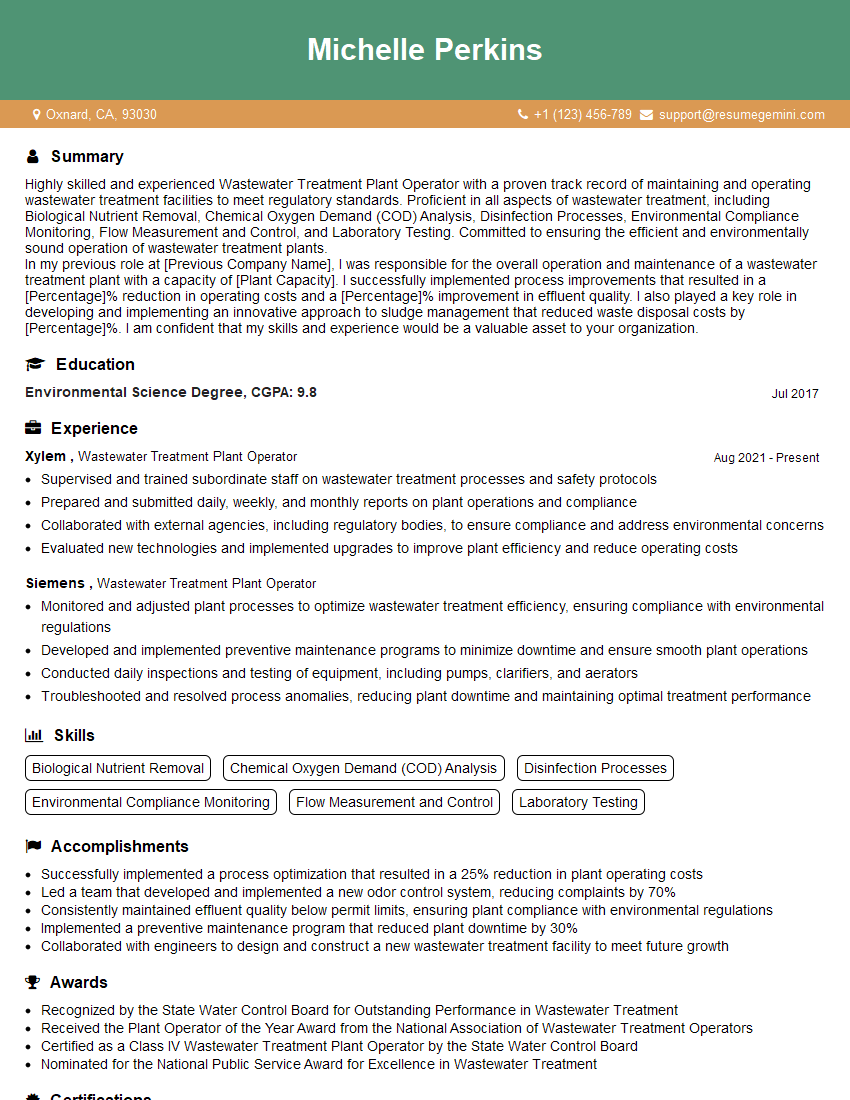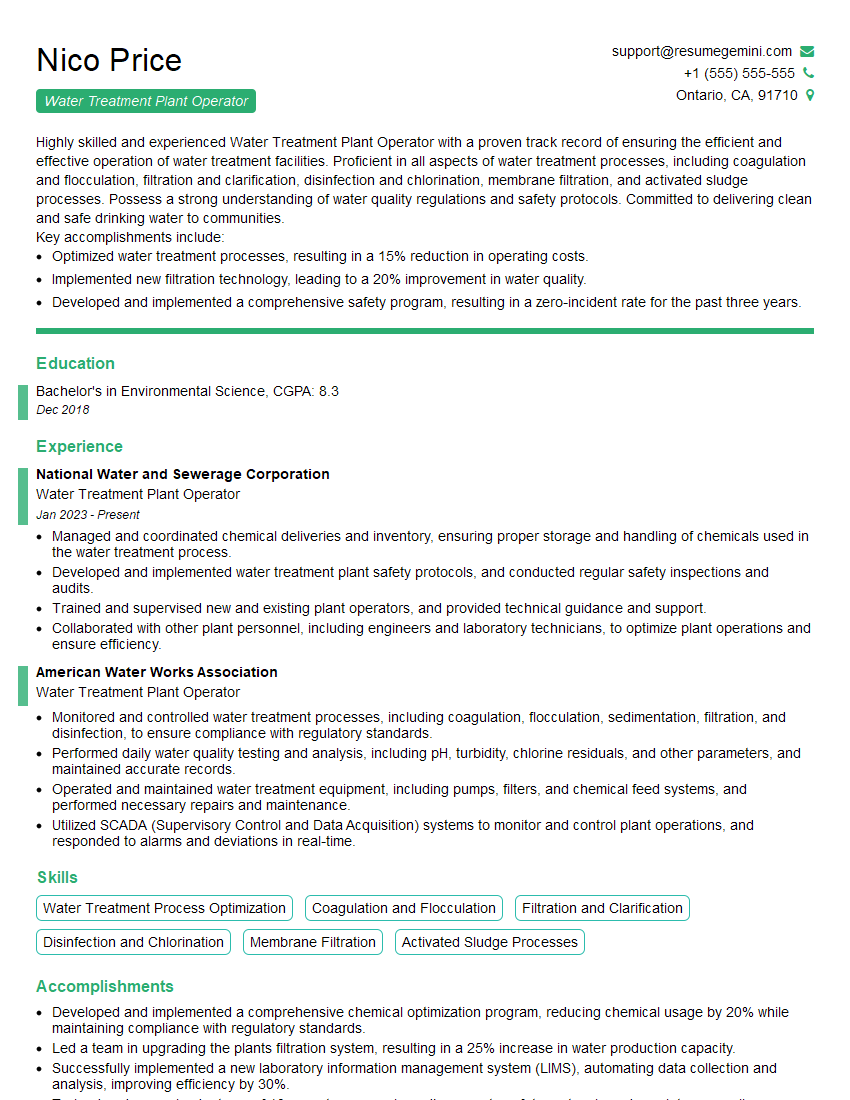The thought of an interview can be nerve-wracking, but the right preparation can make all the difference. Explore this comprehensive guide to Utilities Maintenance interview questions and gain the confidence you need to showcase your abilities and secure the role.
Questions Asked in Utilities Maintenance Interview
Q 1. Describe your experience with preventative maintenance schedules.
Preventative maintenance schedules are the backbone of any efficient utilities operation. They’re essentially a proactive approach, minimizing downtime and maximizing the lifespan of equipment by performing regular inspections and servicing before failures occur. Think of it like getting your car serviced regularly – you catch small issues before they become major, expensive problems.
My experience involves developing and implementing these schedules based on manufacturer recommendations, historical failure data, and risk assessments. For example, I’ve worked on schedules for water treatment plants, where we’d have detailed plans for inspecting and cleaning filters, checking pump performance, and testing chemical levels at specific intervals (weekly, monthly, quarterly, etc.). We’d use CMMS (Computerized Maintenance Management Systems) software to track these tasks, ensuring nothing is overlooked. The key is to tailor the schedule to the specific equipment and its operating conditions. A pump in a high-usage setting will require more frequent checks than one in a low-demand situation.
- Frequency: Schedules are based on the criticality of equipment and its expected lifespan, with higher criticality components receiving more frequent attention.
- Tasks: Detailed checklists specify lubrication, inspection of wear and tear, cleaning, and component replacements.
- Record Keeping: Meticulous documentation is crucial, recording completed tasks, any issues found, and planned future actions.
Q 2. Explain your troubleshooting process for a malfunctioning water pump.
Troubleshooting a malfunctioning water pump is a systematic process, starting with safety and moving to identifying the root cause. It’s crucial to prioritize safety by first isolating the pump electrically before beginning any diagnostics.
- Safety First: Lockout/Tagout procedures must be followed to prevent accidental energization.
- Visual Inspection: Begin with a thorough visual inspection of the pump and its surroundings, looking for obvious signs of damage (leaks, loose connections, debris).
- Check Power Supply: Verify power is reaching the pump using a multimeter. Check fuses, circuit breakers, and motor starters.
- Assess Pressure: Measure the inlet and outlet pressure of the pump using pressure gauges. A significant pressure drop can indicate a problem with the impeller, valves, or piping.
- Listen for Unusual Sounds: Unusual noises (grinding, knocking, whining) can indicate bearing problems or mechanical issues.
- Check Motor Bearings: If the motor is the suspected culprit, check for excessive vibration or play in the bearings.
- Inspect Impeller and Seals: If the problem persists, the pump might need to be disassembled to inspect the impeller for damage or wear, and to check the seals for leaks.
- Hydraulic System Checks: Check the entire hydraulic system for airlocks, leaks, or blockages in the piping.
For example, if I found low outlet pressure with no apparent leaks, I’d suspect a problem with the impeller, requiring further inspection and potentially replacement.
Q 3. How do you prioritize maintenance tasks in a high-pressure environment?
Prioritizing maintenance tasks in a high-pressure environment requires a structured approach. I typically utilize a combination of methods, focusing on criticality and urgency.
- Risk Assessment: Categorize equipment based on criticality (impact of failure) and likelihood of failure. High-criticality, high-likelihood items get top priority. This might involve using a risk matrix (e.g., a 3×3 matrix showing low, medium, and high levels of each factor).
- Urgency: Consider the immediate consequences of failure. A failing pump that’s crucial for a vital service gets immediate attention over a less critical component.
- CMMS Software: Use CMMS software for scheduling, tracking work orders, and generating reports showing task status, backlog, and potential future issues.
- Work Order Management: Implementing a work order system with clear assignment of tasks and responsibilities is paramount.
- Regular Review and Adjustment: Regularly review and adjust the schedule based on changing circumstances and equipment performance.
Imagine a situation with a failing cooling system in a power plant during peak summer demand. That would immediately jump to the top of the priority list, overriding other planned maintenance.
Q 4. What safety protocols do you follow when working with high-voltage equipment?
Safety is paramount when working with high-voltage equipment. My approach follows strict lockout/tagout (LOTO) procedures to ensure the equipment is completely de-energized before any work is done. This is a non-negotiable step.
- LOTO Procedures: Always follow established LOTO procedures, ensuring the power source is isolated and locked out, with tags clearly indicating who has the lockout and what work is being performed. This involves verifying that the power is off using a non-contact voltage tester.
- Personal Protective Equipment (PPE): Appropriate PPE is essential, including insulated gloves, safety glasses, and arc-flash protective clothing, depending on voltage levels and the task being performed.
- Training and Certification: All personnel involved must have received proper training and hold the necessary certifications to work on high-voltage equipment.
- Grounding: Ensure proper grounding to prevent static discharge and electrical shocks.
- Awareness of Surroundings: Always be aware of your surroundings and potential hazards, such as overhead lines or other energized equipment.
- Emergency Procedures: Understand and be prepared to use emergency response procedures in case of an accident.
There’s no room for shortcuts; the risk of severe injury or death is extremely high with high-voltage work. Every step must be carefully considered and executed.
Q 5. Describe your experience with CMMS (Computerized Maintenance Management Systems).
CMMS (Computerized Maintenance Management Systems) are indispensable tools for managing maintenance activities. My experience spans several systems, including both cloud-based and on-premise solutions.
I’ve used CMMS to:
- Schedule Preventative Maintenance: Create and manage preventative maintenance schedules, ensuring timely completion of tasks.
- Track Work Orders: Generate, assign, and track work orders, monitoring their progress and ensuring timely resolution of issues.
- Manage Inventory: Manage spare parts inventory, minimizing downtime due to missing components.
- Generate Reports: Generate reports on equipment performance, maintenance costs, and other key metrics.
- Improve Efficiency: Streamline the maintenance process, improving overall efficiency and reducing downtime.
For instance, using a CMMS allowed me to identify trends in equipment failures, enabling proactive measures like replacing components before failure, ultimately saving time and money.
Q 6. How do you identify and address potential safety hazards on a worksite?
Identifying and addressing potential safety hazards on a worksite is a continuous process. It begins with a thorough pre-job safety briefing and extends throughout the entire project.
- Pre-Job Safety Briefing: Conduct thorough pre-job safety briefings, discussing specific hazards, safety procedures, and emergency plans.
- Site Inspection: Perform a thorough site inspection before work begins, identifying and mitigating potential hazards such as trip hazards, electrical hazards, confined spaces, and hazardous materials.
- Hazard Communication: Clearly communicate identified hazards to all workers involved.
- Personal Protective Equipment (PPE): Ensure appropriate PPE is available and used by all personnel.
- Lockout/Tagout Procedures: Strictly adhere to LOTO procedures when working with energized equipment.
- Emergency Procedures: Have well-defined emergency procedures in place and ensure everyone is familiar with them.
- Incident Reporting: Establish a clear procedure for reporting and investigating any safety incidents or near misses.
A simple example: If I noticed exposed wiring during a site inspection, I’d immediately address it by either de-energizing the circuit or covering the wiring to prevent electric shock.
Q 7. Explain your experience with hydraulic systems maintenance.
Hydraulic systems are crucial in many utility applications, requiring regular maintenance to ensure efficiency and prevent costly failures. My experience includes maintaining various hydraulic systems in different applications.
My maintenance experience encompasses:
- Fluid Level Checks: Regular checks of the hydraulic fluid level and condition. Contaminated fluid can significantly impact system performance.
- Leak Detection and Repair: Identification and repair of leaks, using appropriate sealing methods and components.
- Filter Maintenance: Regular replacement or cleaning of hydraulic filters to prevent contamination.
- Component Inspection: Regular inspection of pumps, valves, cylinders, and other components for wear and tear, and timely replacement of worn parts.
- Pressure Testing: Testing system pressure to ensure it operates within the designed parameters.
- Troubleshooting System Issues: Diagnosing and resolving hydraulic system malfunctions, such as slow response times or complete failure.
For example, in a wastewater treatment plant, I was involved in maintaining hydraulic actuators that control valves in the process. Regular maintenance of these actuators, including oil changes and seal checks, prevented downtime and costly repairs.
Q 8. What is your experience with different types of pumps (centrifugal, positive displacement)?
My experience encompasses both centrifugal and positive displacement pumps, crucial components in various utility systems. Centrifugal pumps, which use a rotating impeller to increase fluid velocity, are prevalent in water distribution networks due to their high flow rates and relatively low pressure. I’ve extensively worked with various types, from single-stage to multi-stage designs, troubleshooting issues like cavitation and seal failures. For example, during a recent project involving a large municipal water pumping station, we identified impeller wear as the source of reduced flow. Replacing the impeller restored optimal performance. Positive displacement pumps, conversely, move a fixed volume of fluid per revolution. I’ve used these extensively in situations requiring precise fluid delivery, such as chemical dosing in wastewater treatment plants. Diaphragm pumps, for instance, are well-suited for handling viscous or corrosive fluids, while gear pumps offer higher pressures. I’ve successfully diagnosed and repaired a faulty gear pump in a sludge transfer system, preventing a major operational disruption.
- Centrifugal Pumps: High flow rate, lower pressure, common in water distribution.
- Positive Displacement Pumps: Precise fluid delivery, higher pressure, used in chemical dosing or sludge transfer.
Q 9. How do you interpret and act upon equipment performance data?
Interpreting equipment performance data is crucial for preventative maintenance and predicting failures. I utilize a combination of methods. Firstly, I analyze historical trend data, looking for deviations from established baselines. For instance, a gradual decrease in pump efficiency, indicated by increasing power consumption for the same flow rate, can signal impeller wear or a clogging issue. Secondly, I examine real-time data from SCADA (Supervisory Control and Data Acquisition) systems, monitoring parameters like pressure, flow, temperature, and vibration. Anomalies in these readings, such as sudden spikes in vibration or temperature, can indicate impending failure. Finally, I incorporate predictive analytics, leveraging machine learning algorithms to identify patterns and predict potential issues before they occur. For example, we’ve used vibration analysis to predict bearing failures in critical pump systems, enabling scheduled maintenance and avoiding costly emergency repairs. This proactive approach significantly minimizes downtime and enhances operational efficiency.
Q 10. Explain your knowledge of different types of valves and their applications.
My understanding of valves extends across various types and their specific applications. Gate valves, for instance, are primarily used for on/off control of large pipelines due to their simple design and robustness. Globe valves, offering precise flow control, are ideal for regulating flow in smaller diameter lines. Ball valves, with their quick on/off action, are common in isolation applications. Butterfly valves provide throttling capability for larger pipelines, but with less precision than globe valves. Check valves, essential for preventing backflow, are found throughout utility systems. In wastewater treatment, I’ve extensively used air release valves to prevent airlocks in pipelines, while pressure relief valves safeguard equipment from overpressure. Selecting the appropriate valve is critical; using a globe valve for large pipeline isolation, for example, would be inefficient and likely lead to increased wear and tear.
- Gate Valves: On/off control, large pipelines.
- Globe Valves: Precise flow control, smaller pipelines.
- Ball Valves: Quick on/off, isolation.
- Butterfly Valves: Throttling, larger pipelines.
- Check Valves: Prevent backflow.
Q 11. Describe your experience with pipefitting and welding techniques.
I’m proficient in various pipefitting and welding techniques. My experience includes working with different pipe materials such as PVC, HDPE, ductile iron, and steel. Pipefitting involves precise cutting, threading, and joining of pipes to create a leak-free system. I’m skilled in using various tools and equipment, including pipe cutters, threaders, and various types of fittings. Welding techniques are crucial for joining metal pipes; I’m certified in both arc welding and stick welding, ensuring strong and durable connections. I’ve successfully completed many projects requiring intricate pipefitting and welding, adhering to strict safety protocols and quality standards. For example, during a recent water main repair, I successfully welded a section of damaged steel pipe, ensuring seamless reintegration into the system without compromising water quality or pressure.
Q 12. How do you handle emergency repairs and breakdowns?
Handling emergency repairs and breakdowns requires a calm, systematic approach. My first priority is always safety – securing the area and ensuring the safety of personnel. Secondly, I rapidly assess the situation to understand the nature and extent of the damage. This involves utilizing diagnostic tools to determine the root cause of the failure. Once the cause is identified, I develop a temporary repair strategy to restore service as quickly as possible, followed by a permanent repair plan. Communication is key; I keep all relevant stakeholders informed about the progress and anticipated restoration time. For instance, during a burst water main incident, we immediately implemented a temporary bypass using available resources to minimize disruption to water supply while initiating a permanent repair. Post-incident analysis is crucial to prevent recurrence, identifying contributing factors and implementing corrective actions.
Q 13. What are your skills in using diagnostic tools and equipment?
I’m proficient in using various diagnostic tools and equipment, including ultrasonic thickness gauges for assessing pipe corrosion, vibration analyzers for detecting bearing failures in pumps and motors, infrared cameras for identifying thermal anomalies indicative of overheating components, and pressure gauges for measuring pressure drops across pipelines. Furthermore, I’m skilled in using specialized software for data acquisition and analysis, aiding in identifying trends and predicting equipment failures. This blend of hands-on experience with advanced diagnostics ensures a thorough and efficient approach to problem-solving.
Q 14. What is your experience with regulatory compliance in the utilities industry?
Regulatory compliance is paramount in the utilities industry. I’m well-versed in relevant regulations, including OSHA (Occupational Safety and Health Administration) standards for worker safety, EPA (Environmental Protection Agency) regulations concerning water and wastewater treatment, and industry-specific codes and standards. My experience includes maintaining detailed records of inspections, repairs, and maintenance activities to ensure compliance. I’m also familiar with the permit process and environmental reporting requirements, ensuring adherence to all legal and regulatory obligations. We regularly conduct internal audits and training to ensure our operations remain compliant. For example, our team has successfully undergone several audits without any major findings and maintained a clean record regarding regulatory compliance. This demonstrates our commitment to safety and legal adherence.
Q 15. Explain your understanding of root cause analysis techniques.
Root cause analysis (RCA) is a systematic process for identifying the underlying causes of problems, rather than just addressing the symptoms. It’s crucial in utilities maintenance to prevent recurrence and improve overall reliability. Several techniques exist, each with its strengths and weaknesses.
- 5 Whys: This iterative technique involves repeatedly asking “Why?” to drill down to the root cause. For example, if a pump fails, we ask: Why did the pump fail? (Overheating). Why did it overheat? (Lack of lubrication). Why was there a lack of lubrication? (Failed oil level sensor). Why did the sensor fail? (Age and wear). Why wasn’t it replaced proactively? (Lack of preventative maintenance schedule).
- Fishbone Diagram (Ishikawa Diagram): This visual tool helps brainstorm potential causes categorized by factors like people, methods, machines, materials, environment, and measurement. It’s excellent for group problem-solving sessions.
- Fault Tree Analysis (FTA): FTA uses a top-down approach, starting with the undesired event (e.g., power outage) and working backward to identify the contributing events and causes. This requires a more detailed understanding of the system.
Choosing the right RCA technique depends on the complexity of the problem and the available resources. Often, a combination of techniques proves most effective.
Career Expert Tips:
- Ace those interviews! Prepare effectively by reviewing the Top 50 Most Common Interview Questions on ResumeGemini.
- Navigate your job search with confidence! Explore a wide range of Career Tips on ResumeGemini. Learn about common challenges and recommendations to overcome them.
- Craft the perfect resume! Master the Art of Resume Writing with ResumeGemini’s guide. Showcase your unique qualifications and achievements effectively.
- Don’t miss out on holiday savings! Build your dream resume with ResumeGemini’s ATS optimized templates.
Q 16. How do you manage and document maintenance activities?
Managing and documenting maintenance activities requires a structured approach to ensure efficiency and accountability. We utilize a Computerized Maintenance Management System (CMMS) to track work orders, schedule maintenance tasks, manage inventory, and generate reports.
The process typically involves:
- Work Order Creation: Each maintenance task generates a work order detailing the problem, location, required parts, and assigned technician.
- Scheduling: The CMMS schedules preventative and corrective maintenance based on equipment needs and technician availability, optimizing resource allocation.
- Task Execution and Documentation: Technicians record their work, including materials used, time spent, and any observations. Digital signatures and photographs enhance documentation quality.
- Parts Management: The CMMS tracks inventory levels, automatically generating purchase requests when parts are low. This prevents delays due to missing components.
- Reporting and Analysis: The system generates reports on maintenance costs, equipment downtime, and technician performance, providing valuable insights for improvement.
Effective documentation is crucial for auditing purposes, ensuring compliance with regulations, and supporting future maintenance decisions. A well-maintained CMMS is indispensable for efficient and effective utilities maintenance.
Q 17. Describe your experience working with various types of motors (AC, DC).
My experience encompasses both AC and DC motors, covering various applications in the utilities sector. I am familiar with their respective principles, common failures, and maintenance procedures.
- AC Motors: I’ve worked extensively with induction motors (the most common type), synchronous motors (used in high-power applications), and servo motors (precise control applications). Troubleshooting often involves checking for voltage imbalances, winding faults, bearing wear, and capacitor failures. Preventative maintenance includes vibration analysis, insulation resistance testing, and lubrication.
- DC Motors: I’ve worked with both brushed and brushless DC motors. Brushed motors require more frequent maintenance due to brush wear and commutator sparking. Troubleshooting focuses on brush condition, armature winding integrity, and field winding issues. Brushless motors are more robust but may require specialized electronic diagnostics.
A recent example involved diagnosing a faulty AC induction motor driving a water pump. Through systematic testing, I isolated the problem to a shorted winding, requiring motor replacement. Proper documentation ensured that the correct replacement was selected and the root cause was addressed to avoid future failures.
Q 18. How do you ensure the proper storage and handling of hazardous materials?
Ensuring the proper storage and handling of hazardous materials is paramount for safety and environmental compliance. We strictly adhere to regulations like OSHA (Occupational Safety and Health Administration) guidelines.
Our procedures include:
- Designated Storage Areas: Hazardous materials are stored in designated, well-ventilated areas, clearly labeled and segregated according to compatibility.
- SDS (Safety Data Sheets): SDSs are readily available for all hazardous materials, detailing their properties, hazards, and handling procedures. All personnel are trained to access and understand this information.
- Proper Labeling and Packaging: All containers are clearly labeled with hazard warnings and appropriate handling instructions. Damaged containers are immediately replaced.
- Spill Response Plan: We have a comprehensive spill response plan outlining steps for containing and cleaning up spills, including appropriate personal protective equipment (PPE) and disposal procedures.
- Regular Inspections: Regular inspections ensure proper storage and handling practices are maintained and that any leaks or damage are addressed promptly.
- Training and Education: All personnel involved in handling hazardous materials receive comprehensive training on safe handling, storage, and emergency procedures.
These procedures minimize risks and ensure compliance with all relevant regulations, safeguarding both personnel and the environment.
Q 19. What is your familiarity with various types of lubricants and their applications?
My familiarity with lubricants encompasses various types and their applications in utilities maintenance. The choice of lubricant depends on factors such as operating temperature, load, speed, and the type of equipment.
- Mineral Oils: Widely used for general-purpose lubrication, offering a balance of performance and cost. Various grades cater to different viscosity requirements.
- Synthetic Oils: Offer superior performance in extreme conditions, such as high temperatures or low temperatures. They provide better oxidation resistance and longer service life.
- Greases: Used for lubricating bearings, gears, and other components requiring long-term lubrication without frequent reapplication. Different greases have varying consistency and operating temperature ranges.
- Specialized Lubricants: Specific lubricants are used for specialized applications, such as food-grade lubricants in the processing of potable water or high-temperature lubricants for turbines.
Proper lubricant selection is critical for equipment longevity and efficiency. Incorrect lubrication can lead to premature wear, increased friction, and equipment failure. Regular oil analysis is essential to monitor lubricant condition and identify potential issues.
Q 20. Describe your experience with electrical testing and troubleshooting.
Electrical testing and troubleshooting is a crucial aspect of my role. I’m proficient in using various instruments and techniques to diagnose and resolve electrical problems.
- Multimeters: Used for measuring voltage, current, and resistance to identify circuit faults and component failures.
- Clamp Meters: Measure current without breaking the circuit, useful for high-current applications.
- Insulation Resistance Testers (Meggers): Measure the insulation resistance of cables and motors to detect insulation degradation.
- Motor Analyzers: Provide detailed analysis of motor performance, identifying imbalances, winding faults, and other problems.
Troubleshooting involves systematically checking voltage levels, current draw, insulation resistance, and continuity. Safety is paramount, and I always follow proper lockout/tagout procedures before working on energized equipment. I recently used a motor analyzer to diagnose a motor with a high vibration level, ultimately identifying a bearing failure that was addressed before it caused catastrophic damage.
Q 21. How do you maintain accurate records of maintenance activities and parts inventory?
Maintaining accurate records of maintenance activities and parts inventory is crucial for efficient operations and compliance. We rely heavily on our CMMS to achieve this.
The system facilitates:
- Automated Work Order Tracking: Every maintenance activity, from scheduling to completion, is documented within the system, providing a complete audit trail.
- Real-Time Parts Inventory: The system tracks parts in real-time, providing accurate inventory levels and automatically generating purchase requests when needed.
- Automated Reporting: The CMMS generates various reports, such as maintenance costs, equipment downtime, and parts usage, enabling data-driven decision-making.
- Data Backup and Security: Regular data backups ensure data integrity, and robust security measures protect sensitive information.
Regular audits and data reconciliation ensure the accuracy of the records, providing a reliable source of information for maintenance planning and performance evaluation.
Q 22. Explain your experience with predictive maintenance techniques.
Predictive maintenance is all about preventing equipment failure before it happens, rather than reacting after the fact. Instead of relying on fixed schedules, we use data and advanced analytics to anticipate potential problems. This significantly reduces downtime and maintenance costs.
In my previous role, we implemented a vibration analysis program for our large pumps. Sensors continuously monitored vibration levels. When anomalies were detected – say, a spike in vibration indicating potential bearing wear – we could schedule maintenance before the pump failed. This prevented a costly shutdown, saving the company thousands of dollars and maintaining consistent water pressure for our customers.
We also utilized infrared thermography to detect overheating in electrical equipment, such as transformers. Early detection of hot spots allows for preventative maintenance, preventing fires and costly repairs. This technology provides a visual representation of heat signatures, pinpointing potential issues.
Another example is oil analysis. Regularly testing the oil from critical machinery reveals the presence of contaminants or degradation, indicating wear and tear and allowing for timely intervention.
Q 23. Describe your experience with different types of bearings and their maintenance.
Bearings are crucial components in rotating equipment, and understanding their types and maintenance is vital. We commonly encounter ball bearings, roller bearings (cylindrical, tapered, spherical), and sleeve bearings.
- Ball bearings are excellent for high-speed applications and are relatively easy to maintain. Regular lubrication and inspection for wear or damage are key.
- Roller bearings handle heavier loads and are used in applications requiring high load capacity. Their maintenance involves checking for proper lubrication, alignment, and signs of wear, such as scoring or pitting.
- Sleeve bearings, also known as journal bearings, are often found in larger equipment like pumps and compressors. These require regular lubrication and monitoring of oil pressure and temperature. Excessive wear can lead to shaft misalignment.
During maintenance, we meticulously inspect bearings for signs of wear, such as excessive play, noise, or unusual vibration. We also check the lubrication and seals. If necessary, we replace bearings proactively to prevent catastrophic failure. Proper alignment is crucial to prevent premature bearing failure; misalignment can cause excessive stress and wear.
Q 24. How do you ensure compliance with OSHA regulations?
OSHA compliance is paramount. We achieve this through a multi-faceted approach emphasizing safety training, risk assessments, and adherence to safety protocols.
- Regular safety training for all personnel covers topics such as lockout/tagout procedures, proper use of personal protective equipment (PPE), hazard communication, and confined space entry.
- Thorough risk assessments are conducted before any maintenance task, identifying potential hazards and establishing appropriate control measures. This includes using Job Safety Analyses (JSAs).
- Strict adherence to safety protocols during maintenance activities ensures the well-being of our employees. This includes using proper tools and equipment, implementing fall protection measures, and following all relevant OSHA standards.
- Maintaining comprehensive documentation of safety training, risk assessments, and incident reports allows us to demonstrate compliance and continuously improve our safety practices.
We also conduct regular safety audits to identify areas for improvement and ensure that our practices remain compliant with the ever-evolving OSHA regulations. A proactive approach to safety is essential for a safe and productive work environment.
Q 25. How familiar are you with different types of electrical transformers?
I am familiar with various types of electrical transformers, including power transformers, distribution transformers, instrument transformers (current and potential), and special-purpose transformers. Understanding their differences is critical for effective maintenance.
- Power transformers are large and used in power generation and transmission, stepping voltage up or down.
- Distribution transformers are smaller and step down voltage for distribution to consumers.
- Instrument transformers are used for metering and protection; current transformers (CTs) measure current, and potential transformers (PTs) measure voltage.
Maintenance involves regular inspection of oil levels and quality, checking for overheating (often using infrared thermography as discussed earlier), monitoring winding resistance, and ensuring proper grounding. We also address any signs of oil leakage or damage to the core or windings.
Q 26. Describe your experience with SCADA (Supervisory Control and Data Acquisition) systems.
SCADA systems are essential for monitoring and controlling utility infrastructure. My experience involves using SCADA systems to monitor critical parameters of equipment such as voltage, current, pressure, and flow rates. This real-time data helps in proactive maintenance scheduling and identification of potential issues. I’m proficient in using various SCADA software platforms and troubleshooting network connectivity issues.
For example, using SCADA, we can remotely monitor the performance of a water pump station. If pressure drops unexpectedly, an alert is triggered, allowing us to investigate the issue immediately and prevent service disruptions. We utilize historical data from SCADA to analyze trends and predict potential equipment failures.
Furthermore, SCADA allows for remote control of certain equipment, facilitating quick response to emergencies and optimizing system performance. This can include things like switching between power lines remotely during maintenance or emergencies.
Q 27. How do you coordinate with other teams to ensure seamless maintenance operations?
Seamless maintenance operations require excellent coordination among various teams. This involves clear communication, scheduled meetings, and a shared understanding of priorities.
I regularly collaborate with operations teams to schedule maintenance during off-peak hours to minimize disruptions to service. We work closely with engineering teams to obtain schematics and technical specifications for complex equipment. The procurement team helps source parts and ensure timely delivery, and with safety teams to ensure safe working practices.
Effective communication is achieved through regular meetings, email updates, and the use of shared online platforms for documentation and task assignments. A clear work order system ensures that all teams are aware of the maintenance tasks and their priorities. This collaborative approach is essential for minimizing downtime and maximizing efficiency.
Q 28. Explain your experience with budget management for maintenance projects.
Budget management for maintenance projects is crucial for ensuring efficient resource allocation. I have experience developing and managing budgets for various maintenance projects, from small repairs to large-scale upgrades.
My approach involves initially creating a detailed cost estimate, which includes labor, materials, and other associated costs. This estimate is then reviewed and approved by relevant stakeholders. During the project, I monitor expenditures closely and identify any potential cost overruns. This involves regular tracking of actual costs against the budget, analyzing variances, and implementing corrective actions as needed. At the end of the project, a thorough financial report is generated, outlining actual costs and comparing them to the budget.
For example, when planning a major overhaul of a substation, we created a detailed budget breakdown that included costs for new equipment, labor, transportation, permits, and contingency funds. By diligently monitoring costs and utilizing value engineering techniques, we were able to complete the project on time and within budget.
Key Topics to Learn for Your Utilities Maintenance Interview
- Preventive Maintenance Strategies: Understanding scheduled maintenance procedures, predictive analysis techniques, and the importance of proactive upkeep to minimize downtime and extend equipment lifespan. Practical application: Explain how you would develop a preventative maintenance schedule for a specific piece of equipment, considering factors like operating hours, environmental conditions, and manufacturer recommendations.
- Troubleshooting and Diagnostics: Mastering fault detection and diagnosis techniques for various utility systems (electrical, water, gas, etc.). Practical application: Describe your approach to identifying the root cause of a system malfunction, including the tools and methods you would utilize.
- Safety Regulations and Procedures: Thorough understanding of OSHA regulations, lockout/tagout procedures, and other safety protocols relevant to utilities maintenance. Practical application: Explain how you would ensure a safe working environment during a complex repair task.
- Repair and Restoration Techniques: Practical knowledge of common repair methods, including welding, pipefitting, electrical wiring, and the use of specialized tools and equipment. Practical application: Describe your experience in repairing a specific type of equipment or system, detailing the steps involved and any challenges encountered.
- Record Keeping and Reporting: Understanding the importance of accurate and detailed documentation of maintenance activities, including work orders, inspection reports, and repair logs. Practical application: Explain your experience with computerized maintenance management systems (CMMS) and how you ensure data accuracy and integrity.
- Teamwork and Communication: Highlighting collaborative skills and effective communication in a team environment, particularly when addressing urgent maintenance issues. Practical application: Describe a situation where effective communication was crucial to resolving a maintenance problem.
Next Steps
Mastering Utilities Maintenance opens doors to a rewarding and stable career with excellent growth potential. To maximize your job prospects, crafting a strong, ATS-friendly resume is crucial. ResumeGemini is a trusted resource to help you build a professional and impactful resume that showcases your skills and experience effectively. We provide examples of resumes tailored to the Utilities Maintenance field to guide you in creating a document that highlights your unique qualifications. Take the next step in your career journey and create a resume that stands out.
Explore more articles
Users Rating of Our Blogs
Share Your Experience
We value your feedback! Please rate our content and share your thoughts (optional).
What Readers Say About Our Blog
This was kind of a unique content I found around the specialized skills. Very helpful questions and good detailed answers.
Very Helpful blog, thank you Interviewgemini team.






